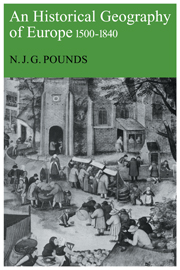Book contents
- Frontmatter
- Contents
- List of maps and diagrams
- List of abbreviations
- Preface
- 1 Europe in the early sixteenth century
- 2 The population of Europe from the sixteenth to the early nineteenth centuries
- 3 The pattern of cities
- 4 Agriculture from the sixteenth to the nineteenth centuries
- 5 Manufacturing and mining
- 6 The pattern of trade
- 7 Europe on the eve of the Industrial Revolution
- Notes
- Index
2 - The population of Europe from the sixteenth to the early nineteenth centuries
Published online by Cambridge University Press: 04 August 2010
- Frontmatter
- Contents
- List of maps and diagrams
- List of abbreviations
- Preface
- 1 Europe in the early sixteenth century
- 2 The population of Europe from the sixteenth to the early nineteenth centuries
- 3 The pattern of cities
- 4 Agriculture from the sixteenth to the nineteenth centuries
- 5 Manufacturing and mining
- 6 The pattern of trade
- 7 Europe on the eve of the Industrial Revolution
- Notes
- Index
Summary
Population was growing rapidly throughout most of the sixteenth century. This expansion had begun in most areas before the end of the previous century and in some was continued into the seventeenth. Then the rate of growth slackened and late in the century it appears to have ceased. The total may even have declined locally, so that the nadir of European population in modern times was reached in the early 1700s. Then slowly it began to expand. The rate of growth accelerated in the second half of the eighteenth century and continued through the nineteenth. Such in broad outline was the course of population change in modern Europe. Not every part of the continent conformed with this model. There were some where the seventeenth-century decline was scarcely experienced and others where it had begun well before 1600. The eighteenth-century recovery began earlier in England than in continental Europe, and earlier in western than in eastern. Nevertheless, there is sufficient unanimity to suggest that there were common features to the demographic history of all parts of Europe.
For most of these centuries the population of Europe displayed characteristics similar to those of the Middle Ages. Both birth-rates and death-rates were high, and the expectation of life short. Population was always pressing against available resources, and any reduction in the accustomed supply of food, even on a small and local scale, was likely to be followed by hardship, even by famine. Disease was endemic, erupting periodically to epidemic proportions, and causing heavy mortality in a population already weakened by malnutrition.
- Type
- Chapter
- Information
- An Historical Geography of Europe, 1500-1840 , pp. 67 - 115Publisher: Cambridge University PressPrint publication year: 1980



